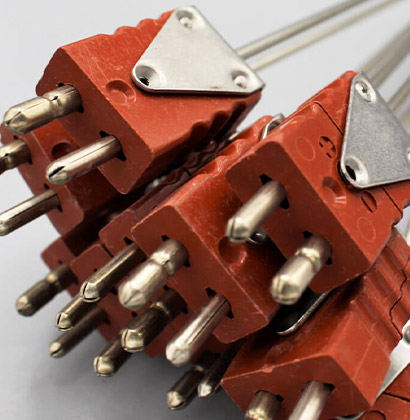 Choosing the right industrial thermocouple is crucial for effective temperature measurement in industrial settings. But what exactly is an industrial thermocouple, and how do you select the best one for your specific needs? This guide highlights the essentials of industrial thermocouples, enabling you to make an informed decision that enhances your operations. By understanding the types, specifications, and applications of thermocouples, you can optimize your temperature measurement process.
Choosing the right industrial thermocouple is crucial for effective temperature measurement in industrial settings. But what exactly is an industrial thermocouple, and how do you select the best one for your specific needs? This guide highlights the essentials of industrial thermocouples, enabling you to make an informed decision that enhances your operations. By understanding the types, specifications, and applications of thermocouples, you can optimize your temperature measurement process.
Understanding Industrial Thermocouples: A Comprehensive Overview
What Is an Industrial Thermocouple?
An industrial thermocouple is a temperature sensor that measures temperature through the principle of thermoelectricity. It consists of two different metal wires joined at one end. When the junction experiences a temperature change, it generates a voltage that can be measured and interpreted as temperature. This simple mechanism makes thermocouples essential in various industrial applications.
How Do Industrial Thermocouples Work?
Thermocouples rely on the Seebeck effect. This means that a voltage is produced when two different metals connect at two junctions and are exposed to different temperatures. The voltage generated is proportional to the temperature difference between the measuring junction (hot junction) and the reference junction (cold junction). This principle allows for accurate temperature readings across diverse conditions.
Advantages of Using Industrial Thermocouples
- Wide Temperature Range: Thermocouples measure temperatures from -200°C to over 2000°C, ideal for extreme environments.
- Durability: They withstand harsh conditions, including vibration, moisture, and dust.
- Quick Response Time: Thermocouples deliver rapid temperature readings, essential for time-sensitive processes.
- Cost-Effectiveness: Compared to other temperature sensors, thermocouples are relatively inexpensive and easy to install.
Types of Industrial Thermocouples: Which One Is Right for You?
Industrial thermocouples come in various types, each suited for specific applications. Understanding these types helps you select the right thermocouple for your needs.
Type K Thermocouples
Type K thermocouples use Chromel (Nickel-Chromium alloy) and Alumel (Nickel-Aluminum alloy). They operate within a temperature range of -200°C to 1260°C and are popular for general-purpose applications. Their versatility and accuracy make them widely used in the industry.
Type J Thermocouples
Type J thermocouples consist of Iron and Constantan (Copper-Nickel alloy). They are suitable for temperatures from -40°C to 750°C. Type J thermocouples work well in vacuum applications and environments with minimal moisture, though they are less stable than Type K.
Type T Thermocouples
Made from Copper and Constantan, Type T thermocouples excel in low-temperature applications, measuring from -200°C to 350°C. They are highly accurate and commonly used in food processing, pharmaceuticals, and cryogenic applications.
Type N Thermocouples
Type N thermocouples use Nicrosil and Nisil and can measure temperatures from -200°C to 1300°C. They offer excellent stability over time, making them suitable for high-temperature applications and environments with significant thermal cycling.
Type S, R, and B Thermocouples
These thermocouples are primarily for high-temperature applications, like metal and glass industries. Type S (Platinum-Rhodium vs. Platinum) can measure up to 1600°C, while Type R and Type B can handle even higher temperatures.
Key Specifications to Consider When Choosing an Industrial Thermocouple
Several specifications are important for optimal performance when selecting an industrial thermocouple.
Temperature Range
Determine the required temperature range for your application. Different types of thermocouples have varying limits, so knowing your specific needs is crucial.
Accuracy and Sensitivity
Accuracy refers to how close the thermocouple’s reading is to the actual temperature. Sensitivity indicates how responsive the thermocouple is to temperature changes. For precision applications, choose a thermocouple with high accuracy and sensitivity.
Response Time
Response time measures how quickly a thermocouple reacts to temperature changes. In fast-paced industrial processes, a quick response time is critical for safety and efficiency.
Junction Type
Thermocouples can have different junction types: exposed, grounded, or ungrounded. Exposed junctions provide fast response times, while grounded junctions balance speed and noise immunity. Ungrounded junctions are useful when electrical isolation is necessary.
Wire Material and Diameter
The wire material affects performance and durability. The wire diameter can influence response time and accuracy. Choosing the right materials and sizes ensures the thermocouple meets environmental demands.
The Importance of Temperature Range in Industrial Applications
Temperature range is a critical factor in selecting the right industrial thermocouple. Industrial processes operate within specific limits, and using a thermocouple outside these requirements can lead to inaccurate readings or equipment damage.
Operating Environments
Consider the operating environment when assessing temperature range. High-temperature applications, like metal processing or furnace operations, require a thermocouple that can withstand extreme heat. Conversely, low-temperature environments, like refrigeration, need thermocouples that measure down to very low temperatures.
Impact on Performance
Using a thermocouple outside its specified range can lead to performance issues. For example, a thermocouple operating beyond its limits may experience drift, causing inaccurate readings. This can negatively impact process control and safety.
Case Studies
In one instance, a manufacturing facility using Type K thermocouples for furnace temperature monitoring found their readings consistently inaccurate due to extreme heat. After switching to Type B thermocouples, which handle higher temperatures, they achieved significant improvements in accuracy and efficiency.
Material Matters: Selecting the Best Thermocouple for Your Environment
The material in industrial thermocouples plays a vital role in their performance and longevity. Different materials resist environmental factors such as corrosion, oxidation, and mechanical wear.
Corrosion Resistance
In corrosive environments, like chemical processing plants, selecting a thermocouple with high corrosion resistance is critical. Thermocouples made from precious metals, like Platinum and Rhodium, are often preferred for their excellent resistance to chemical attack.
Oxidation Resistance
Oxidation can impact thermocouple performance, especially at high temperatures. Materials like Inconel or stainless steel are often used in high-temperature applications to resist oxidation.
Mechanical Durability
In environments with mechanical wear, such as manufacturing or heavy machinery, choosing robust materials that withstand physical stress is essential. Thermocouples with protective sheaths made from durable alloys or ceramics are ideal.
Application-Specific Materials
For specific applications, like food processing or pharmaceuticals, using thermocouples made from FDA-approved materials ensures compliance with safety regulations. The choice of insulation material also affects the thermocouple’s performance and longevity.
Wiring and Installation Tips for Optimal Performance
Proper wiring and installation are crucial for the effective operation of industrial thermocouples. Incorrect installation can lead to inaccurate readings and a decreased lifespan.
Wiring Considerations
When wiring a thermocouple, use the appropriate gauge wire to minimize resistance and ensure accurate readings. Also, use extension wires that match the thermocouple type to prevent errors from differences in material properties.
Location of Installation
The installation location significantly affects performance. Ensure the thermocouple is installed at the correct point in the process where the temperature is representative of the overall system. Avoid placing it near areas with potential heat sinks or sources of interference.
Protection Against Environmental Factors
In harsh environments, consider using protective sheaths or housings to shield the thermocouple from moisture, dust, and mechanical damage. This protection can prolong lifespan and maintain accuracy.
Proper Calibration
Once installed, calibrate the thermocouple according to the manufacturer’s specifications. Proper calibration ensures accurate and reliable readings, essential for process control and safety.
Calibration and Maintenance:
| Specification | Description | Importance in Selection |
| Temperature Range | The maximum and minimum temperatures the thermocouple can measure. | Ensures the thermocouple is suitable for the intended application. |
| Accuracy and Sensitivity | How closely the thermocouple’s readings match actual temperatures and its responsiveness to changes. | Critical for processes requiring precise temperature control. |
| Response Time | The time it takes for the thermocouple to react to temperature changes. | Essential for time-sensitive applications like manufacturing. |
| Junction Type | Types include exposed, grounded, or ungrounded. | Affects response time, noise immunity, and electrical isolation. |
| Wire Material and Diameter | The composition and thickness of the thermocouple wire. | Influences durability, performance, and response time. |
| Calibration Frequency | How often the thermocouple should be calibrated to maintain accuracy. | Regular calibration prevents drift and ensures reliability. |
| Maintenance Checks | Regular inspections for wear and damage. | Helps to catch potential issues before they affect performance. |
Ensuring Accuracy Over Time
Calibration and maintenance are vital for ensuring industrial thermocouples remain accurate and reliable. Regular checks and adjustments prevent costly downtime and ensure compliance with industry standards.
Importance of Regular Calibration
Over time, thermocouples can drift, leading to inaccuracies in readings. Regular calibration identifies and corrects discrepancies, ensuring precise measurements throughout the thermocouple’s lifespan.
Calibration Methods
Several methods exist for calibrating thermocouples, including comparison with a standard thermometer and using temperature baths. The method choice depends on the application and required accuracy level.
Maintenance Tips
- Regular Inspections: Periodically inspect the thermocouple for signs of wear, corrosion, or damage.
- Cleaning: Keep the thermocouple clean and free from contaminants that may affect performance.
- Documentation: Maintain records of calibration and maintenance activities to track performance over time.
Common Applications of Industrial Thermocouples in Various Industries
Industrial thermocouples are widely used across industries due to their versatility and reliability. Here are some common applications:
Manufacturing
In manufacturing, thermocouples monitor temperatures in welding, casting, and heat treatment processes. Accurate readings ensure product quality and prevent defects.
Food and Beverage
In the food and beverage industry, thermocouples monitor temperatures during cooking, pasteurization, and refrigeration. Proper temperature control is critical for food safety and compliance with health regulations.
Oil and Gas
Thermocouples are vital in the oil and gas industry, monitoring temperatures in drilling, refining, and processing operations. Reliable measurements maintain safety and efficiency in high-risk environments.
Pharmaceuticals
In pharmaceuticals, thermocouples monitor temperatures in production and storage environments. Accurate readings are crucial for ensuring the efficacy and safety of pharmaceutical products.
HVAC Systems
In HVAC systems, thermocouples monitor and control temperatures in heating and cooling processes. They help maintain optimal indoor climates and improve energy efficiency.
Troubleshooting Common Issues with Industrial Thermocouples
Despite their reliability, industrial thermocouples can encounter issues affecting performance. Here are common problems and troubleshooting tips:
Inaccurate Readings
If a thermocouple provides inaccurate readings, check for physical damage or corrosion. Verify that the thermocouple is calibrated correctly and that the wiring is intact.
Slow Response Time
A slow response time may indicate thermal lag due to improper installation or insulation. Ensure the thermocouple is optimally installed and not heavily insulated.
Signal Noise
Electrical noise can interfere with readings, especially in environments with high electromagnetic interference (EMI). Use shielded cables and ensure proper grounding to mitigate this.
Drift Over Time
Thermocouples may drift due to aging or exposure to harsh conditions. Regular calibration and maintenance can help identify and correct drift before impacting performance.

